













The Namibian Chamber of Environment (NCE) is an umbrella Association that provides a forum and mouthpiece for the broader environment sector, that can lobby with government and other parties, that can raise funds for its members and that can represent the sector.
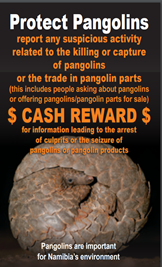
Pangolin Outreach Initiative
Pangolins are believed to be the most trafficked mammals in the world. The biggest demand for pangolins is in Asia, especially China. The main reason is that the scales, made of keratin like our finger nails, hair and rhino horns, are used in traditional Asian medicines and for ornaments and charms. The scales have no medicinal properties. It is an Asian myth that causes huge environmental damage and threatens the survival of these species. Pangolin meat is also sold at high prices in Asian restaurants.
Pangolins have walked the earth for 80 million years. They are insectivores and are harmless to people. They just do good for our environment. They eat ants and termites - millions and millions - as many as 70 million per pangolin per year. That’s about 191,780 insects per day! Imagine an area that is home to 15 pangolins. Those animals alone would eat as many as 1.05 billion insects annually. As you can imagine, pangolins help to control their insect prey’s numbers, contributing to the delicate balance of the ecosystems they inhabit. Termites each grass as well as woody vegetation. Thus, without pangolins to eat termites, the carrying capacity of Namibia’s rangelands for domestic stock and wildlife would be significantly reduced.
Pangolin’s large and elongated claws enable them to burrow underground for shelter and to excavate ant and termite nests for food. In doing so, they mix and aerate the soil - much like what happens when we dig soil in a garden or plough a crop field. This improves the nutrient quality of the soil and aids the decomposition cycle, providing a healthy substrate for the growth of vegetation. Their underground burrows also provide habitat for many other animals, including genets and the rare black-footed cat.
Illegal pangolin trafficking is so common that all eight species of these little-known creatures are categorised as Threatened under the International Union for the Conservation of Nature (IUCN) Red Data listing. Only one species of pangolin occurs in Namibia, Temminck’s ground pangolin Smutsia temminckii, also known as the Cape pangolin and the scaly anteater.
In recent months, there has been a marked increase in the illegal capture, killing and trade in pangolins in Namibia for the international markets in Asia. In light of growing pressure on pangolins, the Namibian Chamber of Environment (NCE) decided to embark on an outreach initiative, to inform Namibians about the precarious status of this animal and to ask everyone to help put a stop to the illegal trade. We need a national effort to tackle the problem of incentivised illegal trade to Asia. Also involved in this initiative are the Ministry of Environment & Tourism, Namibia’s communal conservancies and their NGO support organisations under NACSO, and WWF. We have produced a poster which will be distributed widely across Namibia, and many thousands of business card-sized mini-posters for ever wider distribution. These offers a cash reward for information leading to the arrest of people catching, killing and trading in pangolins and for information leading to the seizure of pangolins or pangolin parts and products. The numbers to call or sms are: 081 413 2214 or 081 423 2231, day or night. All information will be treated in the strictest confidence.
Wildlife crime is an economic and an environmental crime against local communities and against the nation. We ask all Namibians to please help us keep pangolins alive in Namibia, where they belong and where they provide many important ecological services, not dead in Asia where they are of no value to anyone except criminal syndicates.
Copies of the pangolin poster and business card can be collected at the NCE offices, and downloaded using the links below.
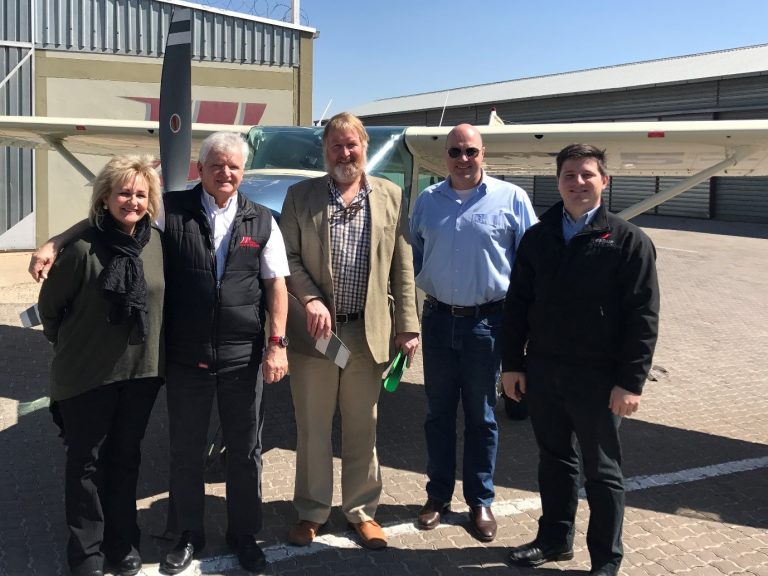
Westair and Namibian Chamber of Environment flying for conservation
Westair Aviation (Pty) Ltd and the Namibian Chamber of Environment (NCE) signed a Memorandum of Understanding on Monday to make a four-seater Cessna C182 aircraft, registration V5-IIM, available to the NCE and its Members to support wildlife protection and conservation in Namibia. The NCE has a membership of over 50 environmental NGOs, all of whom are eligible to use the aircraft and benefit from this extremely generous donation.
The aircraft will fly for conservation. It will be used for aerial wildlife surveys, environmental monitoring and research, surveillance and anti-poaching, and any other similar work to promote conservation, law enforcement and protection of natural resources and Namibia’s environment. Members of the NCE can book the aircraft by contacting the NCE office.
Westair will also cover all line maintenance on the aircraft. Welwitschia Insurance Brokers and Specialised Risk Management (SRM) Ltd have kindly sponsored the insurance of the aircraft. The NCE and its Members are extremely grateful to Westair for their very generous support to the conservation sector, and also to Welwitschia and SRM. If a Member of the NCE needs aerial support but does not have a pilot, Westair will help find an experienced pilot who will volunteer his or her time to fly the Cessna, as a contribution to conservation.
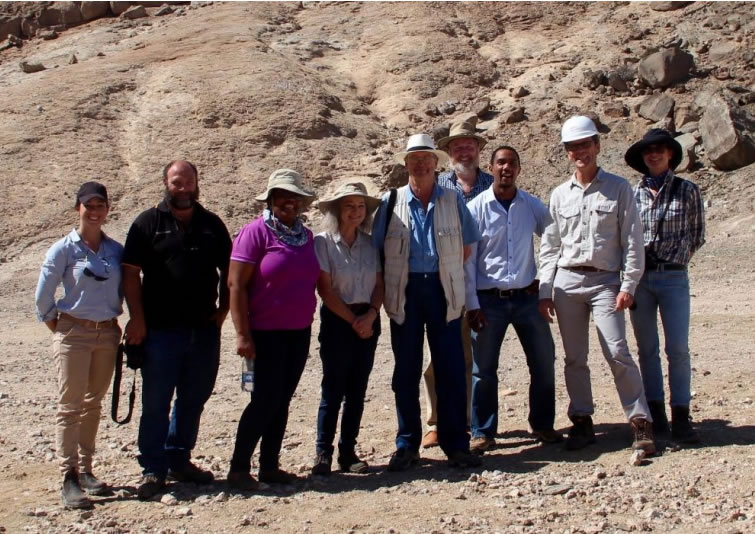
Namibian Chamber of Environment visits Bannerman
On 21 July 2017 six members of the Namibian Chamber of Environment (NCE) visited the Bannerman Mining Resources Site about 40 km east of Swakopmund, near Goanikontes in the Namib Desert. Bannerman Resources undertakes a twice-yearly external environmental audit of its operations. This is done by Alex Speiser (A. Speiser Environmental Consultants). The NCE and its members were invited to participate, engage with Alex and the Bannerman team of Werner Ewald and Tinus Prinsloo, review what is being done and make suggestions.
We inspected all aspects of Bannerman’s operation including their demonstration plant and laboratory, their storage facilities and their rehabilitation work. In addition to rehabilitating their own drilling and bulk sampling areas, Bannerman has rehabilitated many kms of illegal off-road tracks made by irresponsible 4x4 owners. They have also erected signs informing people to not drive off road.
We found that Bannerman sets the highest environmental standards for all aspects of their operation. After much discussion, we had little to offer in the way of improvements – Bannerman was already doing everything right.
But perhaps the most important aspect of our visit was the fact that Bannerman Resources had opened its doors to external inspection, had invited us to review their operations and to make suggestions on how they could improve their environmental management. It is this transparency and commitment to seeking advice for improvement that is at the core of good environmental practice and governance. We applaud Bannerman for its openness and for setting an example. A few other mining companies have also opened their operations for inspection in the past, e.g. Navachab, B2Gold, Rossing Uranium, and we would encourage all mining companies to follow suit.
Photo: The Namibian Chamber of Environment and six of its Member organisations visited Bannerman – Environmental Compliance Consultancy, NACSO, NNF-NamPower partnership, African Conservation Services and Namibian Scientific Society, joining Tinus Prinsloo, Werner Ewald and Alex Speiser at the rehabilitated bulk sampling area (photos Jessica Mooney).
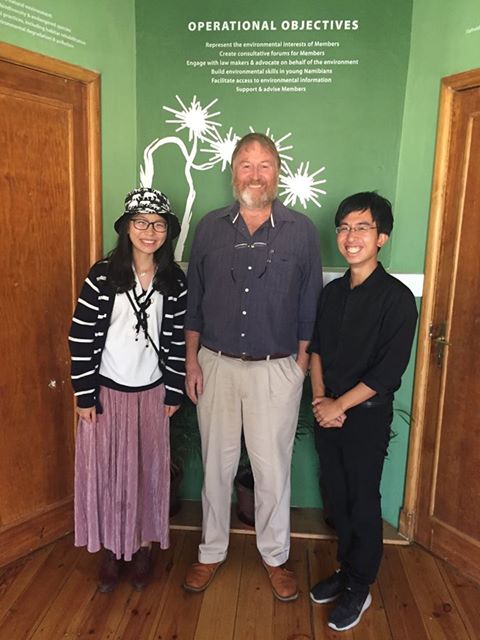
Meeting with Chinese activists
NCE recently met two young, enthusiastic Chinese nationals who visited Namibia. Hongxiang Huang (Hong) and Edwina Zhang work for “China House” in Nairobi, Kenya. Hong is the Founder & CEO of China House - “committed to the development of a socially and environmentally responsible model of Chinese investment in Africa”. Their mission is “to help Chinese companies and individuals better integrate into Africa”.
The NCE suggested to the Chinese Embassy in Windhoek that a similar programme be set up for Namibia or perhaps for southern Africa (Namibia, Botswana, Zambia, Mozambique, Lesotho, Swaziland, Zimbabwe and South Africa). Hong and Edwina are visiting Namibia and the NCE to explore options. A great initiative!
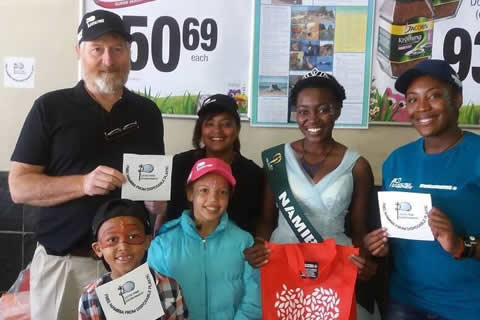
Plastic survey by Maerua Superspar
On Saturday, 22 April 2017, between 09:00 and 12:00, the public completed a multiple-choice survey on plastics, and potential regulations to be imposed on the use of plastics. A total of 82 people completed the survey. The Plastic Free Campaign Petition was also signed by 147 people.
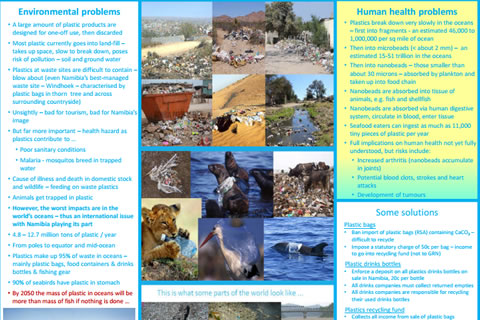
The challenge of plastic in Namibia
On Earth Day, NCE promoted the Plastic Free campaign at SuperSpar Maerua. Many people took advantage of the offer to bring 20 used plastic bags to Superspar Maerua and get a free canvas bag in exchange. In total, several hundred canvas bags were distributed.
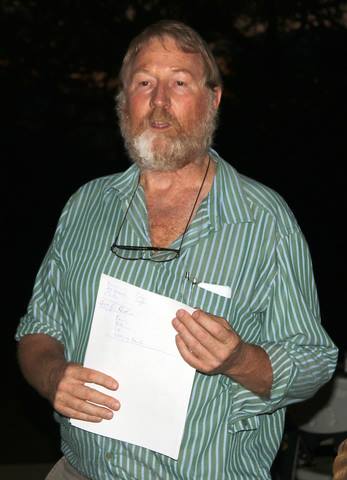
Researchers urged to work together
Newly-formed Namibian Chamber for Environment brings different sectors together
At the very first symposium organized by the Namibian Chamber for Environment on animal movements and satellite tracking in Namibia, researchers from the Ministry of Environment and Tourism and of various NGOs were not only presenting their projects and research results, but also found that the value of their work was enriched when they shared their information.
This led the participants to agree that they should work together more closely in future. A strong partner was found in the B2Gold Namibia mine. General Manager Mark Dawe pointed out that, while even the most careful mining will destroy part of the environment, there are ways for mining companies to invest back into the environment and into socio-economic development. The benefits created can comfortably exceed the costs.
“We as a mine destroy the environment, but we put a lot back and want to do as much as possible for the environment. Here at our Otjikoto Environmental Center we teach especially young Namibians the effect of mining, the environment and what we can do to keep the damages to a minimum and how to rehabilitate as best as possible. Children should learn here what damage can be done, how to avoid unnecessary damage and what a healthy environment looks like”, emphasized Dawe.
Speaking about the role of the newly-established Namibian Chamber of Environment (NCE) the CEO, Dr. Chris Brown said “We want to represent the environmental interests of our members and act as a consultative forum for them. We want to engage with policy and law makers to improve the environmental policy setting in Namibia, as well as effective policy implementation. It is also important to build the environmental skills in young Namibians”.
Another objective of the NCE is to provide support and advise to its members on environmental matters and best practices, as well as to facilitate access to environmental information. With over 30 environmental NGO members, creating an opportunity for members to meet and hold conferences and symposia on important topics is another important role of the NCE.
The symposium took place from 23 to 25 October 2016 at the Otjikoto Environmental Center of the B2Gold Namibia mine north of Otjiwarongo and was attended by over 30 researchers from the Ministry of Environment and Tourism, environmental NGOs and Universities.
Participants came from as far as Scotland, Austria, South Africa, Botswana, and the length and breadth of Namibia. They focused on research with satellite tracking of various types of animals, ranging from elephants, buffalo, zebra, oryx, large carnivores, crocodiles and vultures to seabirds such as cormorants, gannets and penguins.
The organizing committee consisted of Kenneth /Uiseb of the Ministry of Environment and Tourism, Dr. Morgan Hauptfleisch from the Namibia University of Science and Technology, John Mendelsohn from RAISON, Duane Rudman, Otjikoto Nature Reserve Warden, André Rousseau of the Otjikoto Education & Environment Trust and Dr. Chris Brown of the Namibia Chamber of Environment.
The NCE has eight program areas: Membership support, advocacy, environmental policy research, national facilitation, environmental information, young Namibian training and mentorship, fund raising and grants making. “It is important, that data and other information is shared between the different researchers and groups not only in Namibia, but across the subregion and internationally. It is important to develop relevant base data layers useful to a range of tracking data and at the same time keep up to date with international developments in techniques and technology” Dr. Brown pointed out to the participants of the symposium.
A lot of questions remained unanswered and more arose, when comparing the data and try to coordinate the findings. Why do animals respect park borders although there are no fences? Is it because they fear humans and their actions against these animals? Why do unfenced roads seem to be a barrier to elephant breeding herds, which avoid crossing them? Why do vultures breeding in South Africa, Botswana and Namibia seem to use the same core foraging areas across southern Africa, including in areas where the potential to get poisoned is the highest? These are all questions to be answered by working together and push research in this country forward. The NCE will play an important role.
Source: Informante
The proceedings of the Symposium are available on the Environmental Information Service (the EIS).
